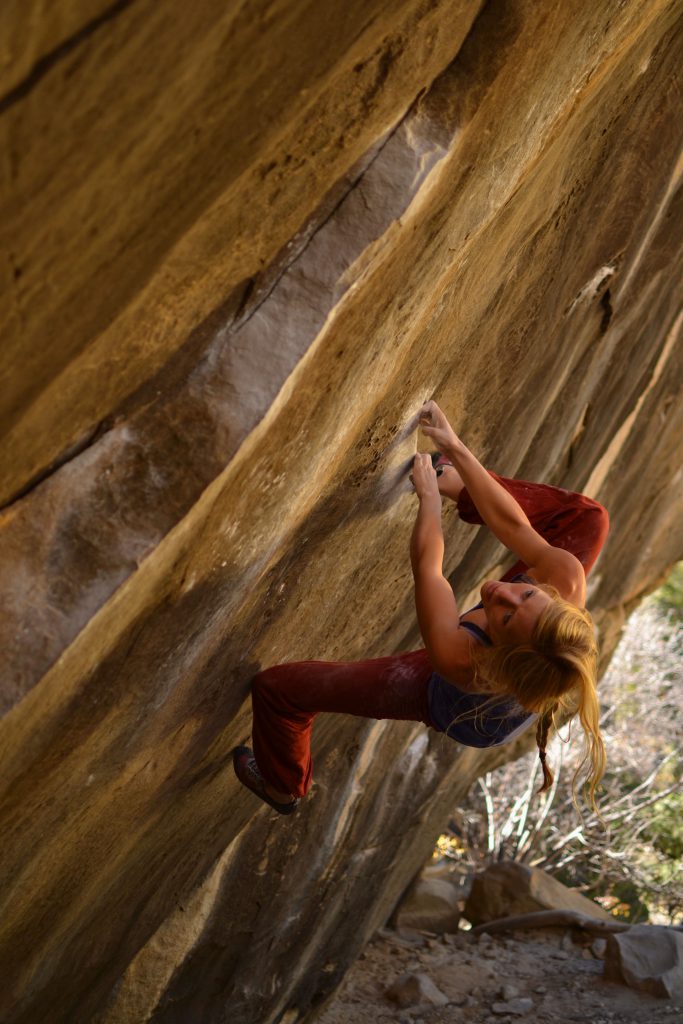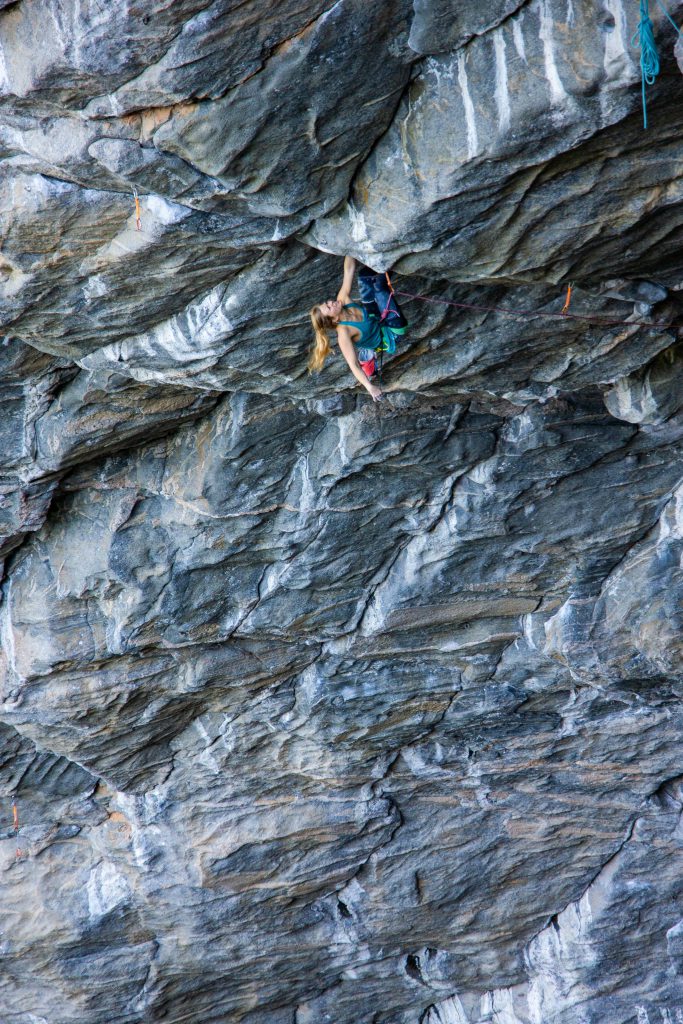Introducing… Mina Leslie-Wujastyk | Lattice Nutrition Coach
When preparing for this interview, I was pretty excited to learn (and share) more about Mina’s expertise in climbing and nutrition. I’ve actually known Mina informally for quite a few years within the climbing community and she’s even had to suffer one of my rather intense training programs in the past so we’ve had a good start! Getting to see more of the “Mina under the surface”, since joining Lattice, has given me an insight into this truly amazing and unique member of our community.
Mina is one of those ultra-experienced climbers who seems to have been climbing forever – 25yrs of rock might seem like a lifetime to many, but knowing her thirst for even more knowledge and understanding, I’d say she still considers herself as only part way through her journey. This is amazing considering that she’s already climbed multiple boulders in the V10-V13 range, represented GB in the World Cups (9th in world in 2013!), and redpointed a number of 8cs. For many, the ticks of this calibre, in a single area would be a dream goal. More on this within the interview…
Aside from her cutting-edge climbing career, Mina has had a super-interesting and varied professional career – something that I know will really impact the work she does at Lattice. Not content with just being a pro climber, she’s immersed herself in some industries that, as a whole, create a valuable blend of skills. She started by qualifying as a Physio in 2008, moved to into Counselling and Psychotherapy before most recently becoming certified in Nutrition via an MNU nutrition course. Amazingly, she continues to have the modesty and hunger for learning that means she continues to work with her mentor Rebecca Dent and is now studying a Sports Nutrition Diploma with the International Olympic Committee. If this wasn’t enough, there is one element added to this that truly makes Mina’s position and insight unique.
As some of you may be aware, she went through a very tough process of dealing with Relative Energy Deficiency in Sport (RED-S) – see article on UKC. As a professional who’s experienced the real-life battles of a chronic low energy availability (that many climbers out there have suffered from or suffer currently), her insight and understanding is unparalleled. Couple with that the openness with which Mina has dealt with the fallout and subsequently recovery, and you have something I’m immensely impressed with. I know that Mina will find it hard to hear, but from my perspective, when you come across someone who’s got the guts to stand up, admit their difficulties and then take them head on, whilst sharing it with others, it’s just plain inspiring.
Right… let’s do this interview!

Could you tell me a bit about your early climbing and how you got so strong?!
Like many people who start climbing as a child, I just went climbing A LOT. As a kid, I loved to boulder and sport climb so those are the building blocks of my climbing enjoyment. I think that a big base of climbing in my early years created resilient fingers and also taught me to move efficiently.
I actually only really started any structured training when I was already on the GB team in my early twenties. As a result, I would say my strong areas are finger strength on the wall (not on a fingerboard weirdly!) and movement skills. It took a while for me to build up greater basic body strength and things that benefit from a more structured training approach.
Despite a period of time doing competitions, outside climbing has always been my passion with many trips focused on both bouldering and sport climbing. Highlights include highballs like Careless Torque in the UK as well as multiple V11s, V12s, one V13 and a handful of 8c routes (UK and abroad). One of the main enjoyments has been getting to travel so much and see so many areas – South Africa, lots of areas in the USA, NZ, Australia and of course Europe and the UK.
As I’ve said at the beginning of this interview, I actually think it’s really cool that you’ve moved forward through RED-S. That’s not an easy thing to do in the public light and also whilst progressing your own nutritional career.
Yes, unfortunately, I missed some important elements of nutrition early on in my climbing career and I didn’t fuel well enough over a period of time – this was a classic example of paying attention to the details but missing the bigger picture – and I developed chronic low energy availability. It was quite a journey to get out of RED-S but so worthwhile and it really brought into focus how important the simple rule of eating enough is. I learnt so much from this experience, in terms of science and nutrition but also how culture, body image and psychology play into food intake as well. I’ve also been formally studying Intuitive Eating. The Intuitive Eating model really resonates with me and I think it’s important to view any nutritional intervention from a bio-psycho-social perspective, but I also think there is a need in climbing for the more traditional evidence-based sports nutrition to be applied. I aim to work from a place where these two models intersect and support one another. As of February 2020, I joined the Lattice Team to help build this service alongside Dr Dave Giles and we are very excited to bring it to life!

As an elite level climber and nutritionist, you must get a pretty unique insight into how climbing and fuelling fit together. Do you think the nutritional rules can be applied all the way down the grade spectrum?
Absolutely. We can go into so much detail and nuance with nutrition but it’s important not to miss the basics – eat enough of the right things regularly to fuel the work you do, recover well and effectively to restore energy and promote adaptation and enjoy the food you eat. These key things will affect you positively whatever grade you climb.
What do you think are a few of the common misconceptions about nutrition and training?
I think there is a huge focus in climbing on “lighter is better” and I see many a climber (and myself in the past) compromise their performance in pursuit of some ethereal lightness that is not sustainable, healthy or even that good for performance. Yes, climbing is what we would call a “weight sensitive” sport but weight is only one data point. Let’s use nutrition to work on developing adaptation from training, to gain power, strength and fitness. We can of course safely look at optimising body composition but this seems to be the first and last port of call for a lot of climbers when it comes to nutrition. Remember, your strength to weight ratio could be better at a higher weight…
You’ve been building a specialist nutrition platform and service with our in-house researcher Dr Dave Giles – can you tell us a little bit about it? We’re excited to know more!
We are really proud of the service we have developed over the last few months. Our aim with this service is to support you individually to navigate the most helpful, relevant and evidence based nutritional strategies for your specific needs. We will work in conjunction with your coach and training plan if you have one (Lattice or non-Lattice) so that we can make your plan bespoke to you and periodised to your training/climbing plans to support your performance.
We want you to feel energised and strong, recover well and reap the benefits of all your hard training and climbing efforts. Our ethos is a food-first approach and we fully understand that food is more than just nutrition. It is also about culture, family, creativity, connection and enjoyment. With that in mind, we want to help you strike the balance of supporting your body for the work you do whilst maintaining a happy, healthy enjoyment of food. We will be conducting a thorough assessment of your current habits, goals and needs and really trying to get to know you in order to create a support system of recommendations that will give you what you are looking for.

What are the main areas of success/reward that you’ve seen when working with clients on nutrition?
A lot of the climbers I have worked with so far have had sub-optimal energy levels and/or recovery from trying to walk a tightrope of eating too little for what they are doing. Invariably in these cases, some adjustments to intake and timings of food can really boost energy levels and thus training and climbing performance. We will always focus on getting the basics right first – from there we can build to optimise even further.
Now that you’re officially part of the Lattice team (yay!) what are the areas where you think we’ll see improvements on, going forward?
I hope that through working with Lattice, we will not only have more success with 1:1 clients but we will also be able to play a role in changing the landscape and messaging about nutrition within the climbing community to a healthier and more sustainable rhetoric.
Absolutely! I can’t say how pleased I am to have you onboard to help share the best knowledge and know-how. Finally, favourite post training food “on the run”? Stuff that we could all have in the car, in the lobby of a climbing wall etc, without a stove or fancy cooking materials.
Oooo…so I love breakfast and often take a replica with me to the crag or for after training…. oats (great energy and fibre source) mixed with Greek yogurt (great complete protein source), berries and banana (micronutrients and fibre), chia seeds (omega-3s and fibre), a little milk and a dollop of good quality nut butter (healthy fats and just yummy). Tupperware is my best friend as it means this tasty, nutritious snack can be taken anywhere.
Thanks so much Mina. I think 2020 is going to be a good year with many positive changes ahead!






